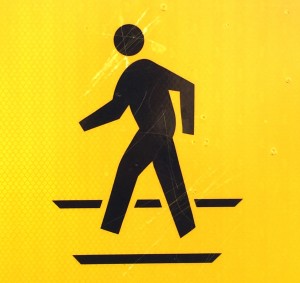
Circle heads and boxy torsos characterize the human figure in ancient paintings and carvings, some dating back 10,000 years or more. Scenes with multiple figures reveal each culture’s visual idea of “everyman.”
Top, left to right: Cova dels Cavalls cave in Valltorta, Spain; Gobustan National Park, Azerbaijan; Sunduki site in Khakassia, Siberia, Russian Federation.
Middle: Bradshaw rock painting, Kimberley region, Western Australia; Newspaper Rock, near Moab, Utah, United States; Modjodje, Mali.
Bottom: Haljesta, Sweden.
Note: Photo sources are listed at the end of the article.
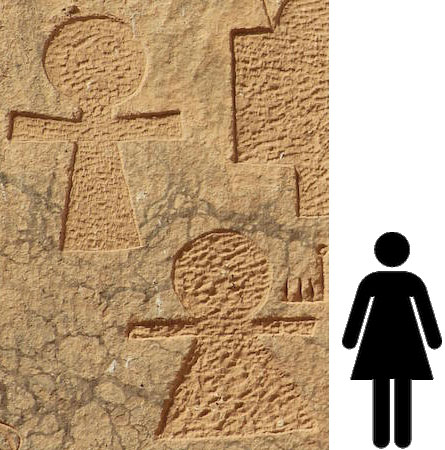
Although not perfectly identical, the two “trademarks” from an ancient Egyptian quarry (Gebel el Silsila, New Kingdom, 16th to 11th centuries BC) adhere to a simplified and standardized form of circle-and-box figure. The figure bears a resemblance to today’s Gwen icon, seen at airports everywhere.

In hieroglyphic writing, simple drawings are standardized and used as words. On the left is the Egyptian hieroglyphic for “man,” from the tomb of Ankhnesneferibre, a princess who died in 530 BC. On the right is a sheet from the Papyrus of Ani (1250 BC), showing cursive hieroglyphics (written on paper). See the “man” hieroglyphic at the lower left and upper right corners and throughout the text.
Medieval to Pre-Modern

In the city seal of medieval Chaumont, France, we see a trend away from the iconic “man” and toward individualizing detail. The central figure has an almond-shaped head, hands with thumbs, and a fashionable tunic with pleats. He might be Charles d’Amboise, who rebuilt the castle in the background. The representation of human figures as unique individuals, in portraits by the likes of Michelangelo, Rembrandt, and Ingres, persisted for quite some time.
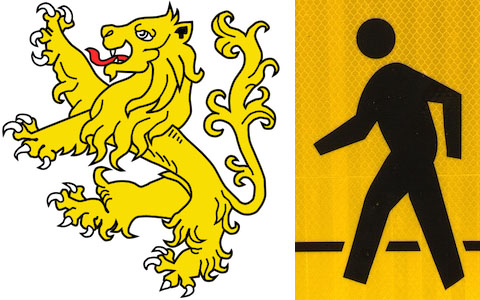
Heraldry held fast to a tradition of iconic representation, though coats of arms typically do not show human figures. In the lion rampant, we see a medieval counterpart to Guy Crossing.

The need for well-recognized trademarks in an industrializing world stimulated new efforts in iconic art. Registration of the Zwilling (“twin”) logo in 1731 was a notable milestone on a road that would one day have crosswalk signage. Learn more about Zwilling/J.A. Henckels at https://www.zwilling.com/uk/en/pages/about-zwilling.html.
20th Century to Present

As mass production and mass media reshaped the modern world, Austrian sociologist Otto Neurath thought there should be a way to communicate the meaning of social and economic statistics to the masses. He worked with artist Gerd Arntz to develop the Isotype system, a collection of symbols to be used in charts about agriculture, banking, household sizes, and so on. The “man” icons in this chart, from Gesellschaft und Wirtschaft (1930), anticipate signage in universal use today. The hats and colors, used to identify race/ethnicity, show the overlap of icon and stereotype.

The Ampelmännchen (“traffic-light guys”) brought the pictorial strategy to crosswalk signals, which previously relied on red/green lights or WALK/DON’T WALK. Psychologist Karl Peglau came up with the idea and his secretary Anneliese Wegner drew the caricatures, which lighted up the daily lives of pedestrians in East Germany after 1961. Something about the stubby figure and quirky hat made the Ampelmann lovable, like the Pillsbury Doughboy.

The trend toward icon signs, or symbol signs, gained momentum in Europe and the US through the 1960s. The V-legged man premiered in European rail stations in 1965 and was adopted by US and Canadian airport associations the following year.
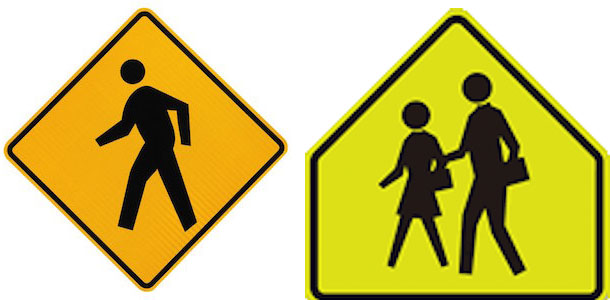
In 1971, a decadal revision of the Manual on Uniform Traffic Control Devices, sanctioned by US state highway officials, introduced the Pedestrian Crossing figure, known in this museum as Guy Crossing. The School Crossing sign, featuring a young Gwen, also debuted in the 1971 MUTCD.
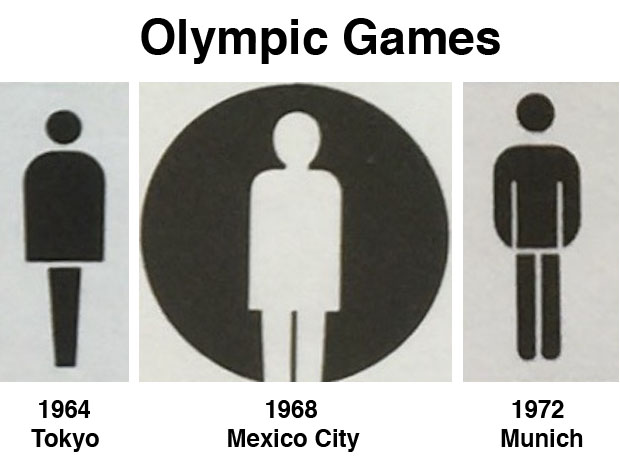
The 1964 Tokyo Olympics were the first to post signs with icons instead of words for the convenience of international travelers. The icons, developed by Masaru Katzumie, showed where to find a phone, food, gift shop, etc. His icon for men’s bathroom has a tombstone-shaped torso. Later designs used white space to separate the arms from the body.
The 1968 and 1972 Olympics developed their own sets of icons. Mexico City’s “man” kept the Tokyo torso but separated his legs and gave him a neck. In Munich, designer Otl Aicher created icons using a grid system, which prescribed the taper of the hands and the increased gap for the neck. Strangely, the jacket hemline from Tokyo made a comeback in 1972 though Munich man was no longer wearing a jacket.

In 1972, the US Department of Transportation commissioned the American Institute of Graphic Arts (AIGA) to develop icons identifying facilities for travelers. After a review of signs in other countries, AIGA hired Roger Cook and Don Shanosky to create a new set of icons that would incorporate the best features of previous designs. Their “man,” known within this museum as Guy Airport, has the rounded feet and geometric angles of Aicher’s 1972 Munich man. See all 50 of the AIGA icons at http://www.aiga.org/symbol-signs/.
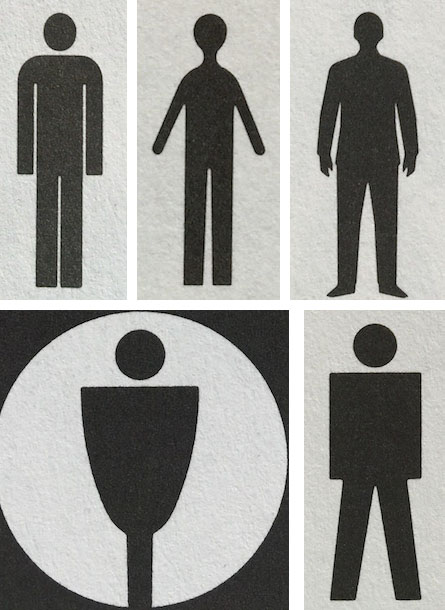
In AIGA’s 1972 review of international signs, these five figures were the most distinctive – now forgotten Guys of yesteryear (left to right):
- Expo 67 (Montreal, 1967): My sleeves are too long!
- German Airports Association (1968): ET neck and head
- International Civil Aviation Organization (Canada, 1970): Realistic silhouette
- Tokyo Airport (1970): Pearl dropping into a goblet
- British Airports Authority (1972): Man carrying a TV set
Back to Home – Guy Crossing Museum
References
American Association of State Highway Officials. Manual on Uniform Traffic Control Devices (1971). Richard C. Moeur site. 29 Feb. 2016. http://www.trafficsign.us/1971mutcd.html
American Institute of Graphic Arts. Symbol Signs. New York: Visual Communications Books, Hastings House Publishers, 1981.
Gomez-Palacio, Bryony, and Armin Vit. Graphic Design Referenced: A Visual Guide to the Language, Applications, and History of Graphic Design. Beverly, MA: Rockport Publishers, 2009.
Hawkins, H. Gene. “Evolution of the MUTCD: The MUTCD Since World War II.” ITE Journal 11 (1992): 20. Web. 10 Feb. 2016. https://ceprofs.civil.tamu.edu/ghawkins/MUTCD-History.htm
Meggs, Philip B. A History of Graphic Design. New York: Van Nostrand Reinhold, 1983.
Photo Sources
Cova dels Cavalls cave in Valltorta. Cropped from a photo by Joanbanjo via Wikimedia. https://commons.wikimedia.org/wiki/File:Escena_de_ca%C3%A7a_de_la_cova_dels_Cavalls,_reproducci%C3%B3_del_museu_de_la_Valltorta.JPG
Gobustan National Park, Azerbaijan. Cropped from a photo by Azeri via Wikimedia. https://commons.wikimedia.org/wiki/File:Ancient_Azerbaijan_4.jpg
Sunduki site in Khakassia, Siberia. Cropped from a photo credited to “‘Petroglyphs of ancient Siberia’, courtesy Alexander Zaika” in The Siberian Times, 13 April 2013. http://siberiantimes.com/other/others/news/is-this-the-oldest-astronomical-observatory-in-the-world-dating-back-16000-years/
Bradshaw rock painting, Kimberley region, Western Australia. Cropped from a photo on Wikimedia. https://commons.wikimedia.org/wiki/File:Bradshaw_rock_paintings.jpg
Newspaper Rock, near Moab, Utah. Cropped from a photo by Carol M. Highsmith via the Library of Congress. http://www.loc.gov/pictures/item/2011630114/
Modjodjé, Mali. Cropped from a photo credited to Mission Archéologique et Ethno-arquéologique Suisse en Afrique de l’Ouest (MAESAO) in the TRACCE Rock Art Bulletin. http://www.rupestre.net/tracce/?p=1668
Haljesta, Sweden. Cropped from a photo at Wikimedia. https://commons.wikimedia.org/wiki/File:Haljesta.jpg
Quarry marks ancient Egypt. Cropped from a photo by M. Nilsson in The American Research Center in Egypt. http://arce.org/news/u117
Hieroglyphic from the tomb of Ankhnesneferibre. Cropped from a photo © Hans Hillewaert / CC-BY-SA-4.0 via Wikimedia. https://commons.wikimedia.org/wiki/File:Sarcophagus_of_Ankhnesneferibre.jpg
Papyrus of Ani. Cropped from a photo on Wikimedia. https://commons.wikimedia.org/wiki/File:Papyrus_Ani_curs_hiero.jpg
Seal of Seal of Chaumont-en-Vexin. Hesburgh Libraries, University of Notre Dame. https://library.nd.edu/medieval/seals/muni/d5575.shtml
Lion rampant via Wikimedia. https://commons.wikimedia.org/wiki/File:Lion_Rampant_queue_fourche.svg
Zwilling/J.A. Henckels trademarks. https://www.zwilling.com/uk/en/pages/about-zwilling.html
Otto Neurath world population chart. Wirtschafts Museum (Germany). http://www.wirtschaftsmuseum.at/media/publikationen/otto_neurath/Atlas_Neurath_Gesellschaft_und_Wirtschaft_Beispiele.pdf
Ampelmannchen via Wikimedia. https://commons.wikimedia.org/wiki/File:Ampelmann.svg
All icons are from AIGA, Symbol Signs, cited in References.
The Guy Crossing Museum (GCM) is an educational work. A conscientious effort has been made to avoid infringement of copyright. Contact the GCM administrator at karlstull.com.
Back to Home – Guy Crossing Museum
